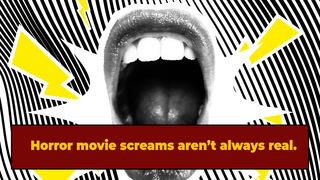People Get Paid To Be Professional Screamers

Halloweekend has come and gone, and if you're anything like me, you slipped at least one horror classic into your festivities. While this year, I stuck with Cartoon Network's Over The Garden Wall and the grossly underrated sapphic Halloween flick that is Jennifer's Body, for others, it's the best time of the year to bust out the old classics, like Psycho, Get Out, Paranormal Activity, and of course, the aptly titled Jamie Lee Curtis classic that is Halloween (believe it or not fellow zoomers, her entire career isn't just Scream Queens, Freaky Friday, and probiotic yogurt commercials). Yet what if I told you that like the blood, scary SFX, and pretty much everything else in those films, the screams were fake, too?
Well reader, they most often are, and business is booming, according to a new feature from The New York Times. Think of it this way -- why would you risk blowing out a microphone, or your A-list star's vocal cords, attempting to get a high-quality screech when there are faster and more effective ways to get a truly terrifying wail? As sound designer Trevor Gates, who worked on projects including Us, Get Out, and The Haunting of Bly Manor, "There's a psychology of the sound. The bottom line is the performance of what you’re doing -- it's the visceralness, it's the reality of hearing someone who could potentially be in pain. It’s a scary thing, and it’s a hard thing to recreate." In searching for the perfect scream, sound designers usually have a few choices.
Don't Miss
Firstly, they can turn to pre-canned screams (no, not like Monsters Inc.) or pre-recorded, existing screams one can throw in a scary scene to add terrifying pizzaz. The most famous one? The Wilhelm. First appearing in The Charge at Feather River, a 1953 western in which a character named Private Wilhelm is shot in the leg with an arrow, the sound has been used in 453 films and movies since its debut, according to its IMDB page, including Once Upon A Time in Hollywood, Inglourious Bastards, per director Quinten Tarantino's request, and even Pixar's family-friendly classic, Toy Story. While the sound has since become some sort of a meme, representing how difficult it can be to capture male screams convincingly, archives sometimes come in handy in these situations. Gates' keyword of choice in finding that perfect wail from his database? "Death Screams." Nice.
Secondly, voice actors can help do the trick. Take, for example, Ashley Peldon. Although you may have never heard her name, most horror fans have heard her shrieks. Specializing as a rage screamer, her work has been featured in films ranging from Okja to Child of Rage, and she says she records "a smorgasbord of screams" from her home studio, risking damaging her vocal cords along the way. But why is this variety so important in capturing an expression of fear? When it comes to screams, like most things in life, one size doesn't fit all. "A mother seeing her child getting run over by a car, that's going to be an incredibly different scream than someone being stabbed by a knife punch into a closet," said Graham Reznick, another sound designer who has worked on several horror projects.
Sound designers can craft the perfect scream by making it themselves, combining many sounds to get that perfect fear-inducing shriek. "A lot of times screams are Frankensteined from four or five different people, just to make it work for the six seconds you need onscreen," Reznick explained. "I once replaced John Travolta's death gurgles with my own voice." I guess pronouncing Idina Menzel's name isn't the only sound Travolta struggles with.
So next time you're watching your favorite scary movie, know that those screams are truly an art -- they scream so we can scream ... at them screaming.
For more weird internet content, follow Carly on Instagram @HuntressThompson_ and Twitter @TennesAnyone.